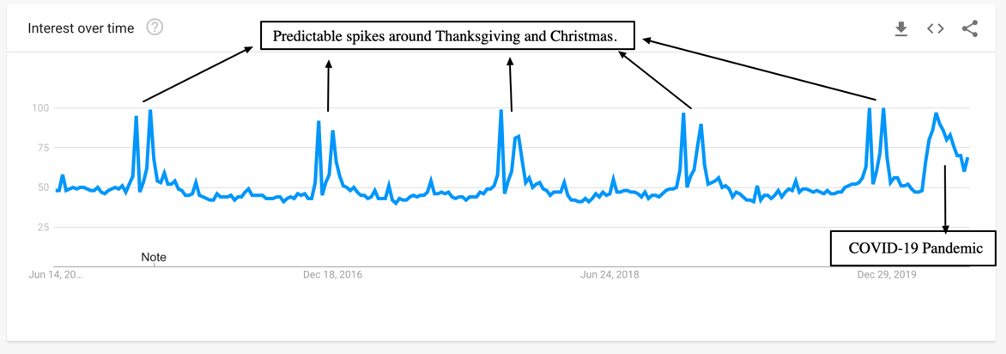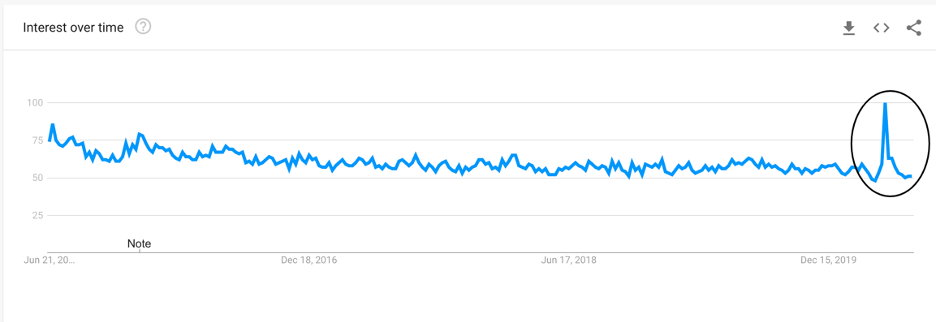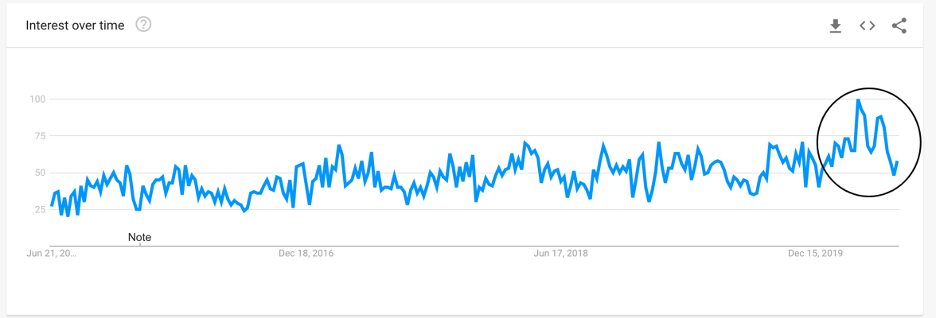Adapting to Changes in Search Trends
During this time of global uncertainty, many things have changed. “Non-essential” workers set up their home offices and got familiar with Zoom. In fact, daily Zoom downloads went from 56k in January to 2.13 million in March. Our lives and habits changed dramatically, so too did the way we searched and the things we searched for. As a Paid Search Analyst and PPC expert, I have to pay very close attention to these changes as they can greatly impact the performance of my Campaigns and the bottom line for my clients.
Identifying Changes in Search Patterns with Google Trends
Google Trends is a great way to look and see patterns of behavior regarding specific searches, but even for a marketer that’s not regularly in that tool, you should be looking at your Campaign data and search terms month-over-month and quarter-over-quarter at the bigger picture on occasion to pick up on relevant trends. More on that later, but first, Google Trends.
For example, let’s look at the trends for “recipe” search terms over the last 5 years:

As you can see, search patterns follow predictable patterns of seasonality focused on large spikes in demand/traffic near Thanksgiving and Christmas. But COVID-19 caused an equal (and prolonged) spike in demand/traffic because folks are at home all day and if they’re like me, then they ran out of recipes after 2 weeks at home. The dramatic change is even more pronounced for “food delivery” search terms:

But these changes are not limited to the food industry. For the banking industry, the focus shifted dramatically to online banking:

For senior living, there’s been a rise in interest in “age in place” programs:

Recognizing Changes in Search Patterns Without Google Trends
When big changes happen in search patterns and behavior, Paid Search Analysts (or PPC experts or whatever you like to call them) will see abnormal changes in metrics, typically in Impressions, CTR, Conversions, CPA or other performance indicators. You may also see a change in your typical search terms. This is something you should be looking at month-over-month at least. If you’re paying attention, you’ll be able to catch these shifts in user behavior and be able to capitalize on them. It’s also helpful to apply some common sense – with a global pandemic going on, of course, people are more interested in services that allow them to stay safe.
Capitalizing on Changes in Search Patterns
Once you’ve identified certain features of your business that are rising in demand or popularity (like contactless delivery, the ability to chat online for customer service, etc.) then you need to market those selling points aggressively. Here are some ways to incorporate those selling points to capitalize on search patterns:
- Ad Extensions – In Google Ads, ad extensions can help boost your CTR by allowing your ad to take up more visual space, making it more prominent on the page. However, using your ad extensions – like Callout Extensions – to highlight popular selling points is going to boost your CTR and get you more Clicks. Use Call Extensions to allow users to call you with one click if they just want to get in touch with you immediately. Make it as easy as possible for them to convert into customers. Price Extensions are another
- Updating Ad Text – Utilize the third headline (H3) space and second description (D2) spaces to highlight and explain additional selling points. Using the full amount of space possible for your ads with information that is relevant and useful will also make your ad more prominent, increasing CTR and Click volume.
- Update Website – Most companies were quick to put up a response or statement about COVID-19 detailing how they would implement safety measures or change the way they do business. In addition to having that information on a page on your website, consider adding or changing a banner image or some element of your homepage to get those key features out in front of your whole audience rather than burying it in a webpage three clicks deep into your site.
Follow Up
Once you’ve implemented your changes, your job isn’t necessarily done. If trends have subsided, you should switch out your ad text back to more neutral language or highlight your most popular features instead of trend-specific features. If you also terminate any features after the trend subsides, be sure to remove all language around it so you’re not advertising features or deals you no longer provide.



